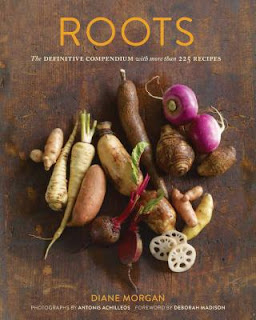There are some people who can wax poetic about a leafy green salad.
Iceberg
Romaine
Chicory
Frisee
Mache
mix them with mint, coriander, chive, and parsley. Yeah, yeah yeah… but me, give me a dirty old root anyway.
Roots are my favorite, so you cannot imagine how happy I was to grab a copy of Diane Morgan’s Roots.
If you are thinking potatoes and carrots, well you are right but there is so much more. Take the wonderful rutabagas. How often do I see folks stroll right past this titanic taproot without ever giving it a second look? I admit, the rutabaga is a bit hard to peel and in order to keep the root moist for travel; it has to be coated in paraffin so it doesn’t dry out. And we call it a rutabaga instead of the more friendly British “swede.” Rutabaga is named from the Swedish rota bagge or “root bag” but since it is from Sweden, it is called a swede or a neep in Scotland. Frankly I believe more people would eat rutabagas if we called them swedes, but I digress…
The rutabaga is a true root, a taproot like the carrot, and turnips and radishes and salsify. There are tuberous roots like sweet potatoes and yuca. There are rhizomes like ginseng and ginger. Corms like water chestnuts and taro. And finally stem tubers like the great potato. Yes, Virginia, root veggies are a complicated matter and Diane Morgan is more than happy to explain it all to us.
Roots is both a detailed examination into the history and botany of root vegetables, but more importantly, a collection of more than 225 recipes for great main dishes and glorious sides. Really, you can’t beat a big old pan of roasted root vegetables, but they are ever so versatile. The book is filled with salads and gratin, pickles and biscuits and my favorite parsnip cake (a carrot cake with grated parsnips instead of carrots).
Roots gives the respect and admiration to the root, which is a kitchen workhorse and now, the star of the show. As a root lover, even I was impressed with the amazing versatility of roots. Not wanting to overwhelm you, but being very desirous that you grab up a big old rutabaga on your next shopping trip, here is a simple and tasty root bag of goodness.
Honey-braised Rutabagas3 tbsp unsalted butter2 lb rutabagas, ends trimmed, peeled and cut into 3/4 inch cubes2 cups homemade chicken stock or canned low-sodium chicken broth3 tbsp honey1 tsp kosher salt or fine seas salt1/4 tsp freshly grated nutmegFreshly ground pepper1. In a large sauté pan, melt the butter over medium-high heat and swirl to coat the pan bottom. Add the rutabagas, stock, honey, and salt and bring to a boil. Reduce the heat so the liquid just simmers, cover and cook, stiffing occasionally, until the rutabagas are fork-tender but not falling apart, about 20 minutes.2. Uncover the pan, increase the heat to high, and boil the braising liquid, stirring occasionally, until it reduces to a syrup consistency and coats the rutabagas, about 10 minutes. Stir in the nutmeg and season with pepper. Serve immediately.
Go ahead, tell your family that swedes are on the menu. The sweetness of this recipe will counteract the spiciness of the rutabaga. Who knows, this just might become your go-to tuber; and face it, everyone needs a go-to tuber.























